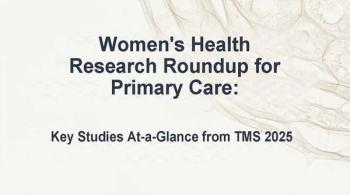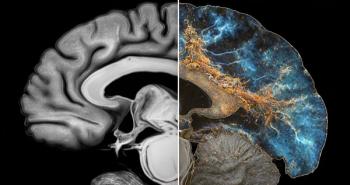
Plasma Biomarkers Achieve High Accuracy for Confirmatory Aβ Positivity in Eligibility Test for DMT in Alzheimer Disease
Plasma assays combining p-tau217 and Aβ42/40 accurately confirm AD, supporting patient eligibility for anti-amyloid disease-modifying therapies.
A new validation study using
In analyses representing both the continuum of AD severity and DMT-eligible populations, the p-tau217/Aβ42 ratio achieved diagnostic accuracy comparable to cerebrospinal fluid (CSF) biomarkers. In the Alzheimer’s Disease Continuum Cohort (ADCC), the ratio yielded an area under the curve (AUC) of 0.961, with 93% sensitivity, 92% specificity, and 93% overall accuracy. In the Intention-to-Treat Cohort (ITTC), which was structured to mirror participants meeting DMT eligibility criteria, the AUC was 0.959, with 99% sensitivity and 95% accuracy.1
When investigators applied dual cut-offs balancing sensitivity and specificity at 95%, the combined measures maintained 93% accuracy. The ITTC cut-offs met confirmatory assay criteria for DMT use, supporting their potential role in clinical assessment. The findings, from scientists at Australia's Commonwealth Scientific and Industrial Research Organisation (CSIRO), were published in the journal Alzheimer's & Dementia.1
Biomarker Confirmation Now Essential
“With treatments for [Alzheimer] disease biology becoming available, it’s critical we have accurate, scalable and less invasive tests to identify eligible patients,” lead author James Doecke, PhD, research scientist at CSIRO's Australian e-Health Research Center, said in a statement.2 Tests must specifically confirm abnormal Aβ levels, he added. Eligibility for treatment depends on the same biomarker criteria used in pivotal trials for lecanemab3 and donanemab.4 CSF assays have traditionally provided this confirmation, but newer plasma-based assays offer a novel alternative, the team wrote.1
For a blood-based biomarker (BBM) to serve as a confirmatory test, its sensitivity and specificity must approximate those of core CSF biomarkers, which is typically approximately 90% for both measures.5 Tests meeting 90% or greater sensitivity with slightly lower specificity (85% or greater in primary care or greater than 75% to 85% in secondary care) may be used for triage.5 The Fujirebio p-tau217/Aβ42 ratio was
Subcohorts. The team evaluated the performance of Lumipulse plasma p-tau217 and Aβ42/40 assays, individually and in combination, for predicting Aβ positron emission tomography (PET) status. Samples came from 2 subcohorts of the Australian Imaging, Biomarkers, and Lifestyle (AIBL) Study of Aging:
- ADCC (N = 197): individuals across the AD continuum, including cognitively unimpaired participants (Aβ– and Aβ+).
- ITTC (N = 200): participants approximating DMT eligibility, primarily with mild cognitive impairment or mild AD.
Aβ PET positivity was defined as a Centiloid (CL) value equal to or greater than 25. All analyses were conducted on the Fujirebio Lumipulse G1200 platform.
Findings
In the ADCC, p-tau217/Aβ42 and p-tau217 alone achieved the highest AUCs (0.961 and 0.941). Linear models combining p-tau217, Aβ42/40, age, sex, and APOE ε4 status improved predictive performance in both cohorts, according to the study findings.1
In the ITTC, the composite model reached approximately 97% accuracy, and the combined p-tau217 + Aβ42/40 model achieved ~96.5%. When the investigators applied a single cut-off to the p-tau217/Aβ42 ratio, the result was 99% sensitivity and 86% specificity. They reported that using dual cut-offs (95% sensitivity and specificity) eliminated intermediate results in the ITTC and left 13% of participants in the intermediate zone for the ratio alone, within the recommended less than 15% up to 20% range.1
Among the study's limitations the authors acknowledge that the ADCC and ITTC were analyzed about 12 months apart, and a small number of false positive results were observed. In addition, the cohort was relatively homogenous, drawn entirely from Australia, highlighting the need for further evaluation in more diverse populations.1
Overall, however, Lumipulse plasma p-tau217 and Aβ42/40 assays showed high accuracy in predicting Aβ PET status across disease stages. "Collectively, our findings demonstrate that BBMs can work as well as CSF biomarkers here to predict the presence of high Aβ in the brain, providing the opportunity to use these tests routinely both in the clinic and in clinical trials to aid in the DMT journey," the authors concluded.1
References
Doecke JD, Chenna A, Lo M, et al. Combining Lumipulse p-tau217 and Aβ42/40 as confirmatory tests for Aβ positivity prior to disease-modifying therapy. Alzheimer’s Dement. 2025;21:e70707. doi:10.1002/alz.70707
New blood test could streamline Alzheimer's diagnosis and treatment access. News release. CSIRO. October 21, 2025. Accessed October 21, 2025. https://www.csiro.au/en/news/All/News/2025/October/Alzheimers-blood-test
McDade E, Cummings JL, Dhadda S, et al. Lecanemab in patients with early Alzheimer’s disease: detailed results on biomarker, cognitive, and clinical effects from the randomized and open-label extension of the phase 2 proof-of-concept study. Alzheimers Res Ther. 2022;14(1):191. doi:10.1186/s13195-022-01124-2
Sims JR, Zimmer JA, Evans CD, et al. Donanemab in early symptomatic Alzheimer disease: the TRAILBLAZER-ALZ 2 randomized clinical trial. JAMA. 2023;330(6):512-527. doi:10.1001/jama.2023.13239
Schindler SE, Galasko D, Pereira AC, et al. Acceptable performance of blood biomarker tests of amyloid pathology—recommendations from the Global CEO Initiative on Alzheimer’s Disease. Nat Rev Neurol. 2024;20(7):426-439. doi:10.1038/s41582-024-00977-5
Halsey G. FDA clears first plasma-based assay to aid Alzheimer Disease diagnosis. Patient Care. May 17, 2025. Accessed October 21, 2025. https://www.patientcareonline.com/view/fda-clears-first-plasma-based-assay-to-aid-alzheimer-s-disease-diagnosis
Newsletter
Enhance your clinical practice with the Patient Care newsletter, offering the latest evidence-based guidelines, diagnostic insights, and treatment strategies for primary care physicians.


















































































































































































































































































